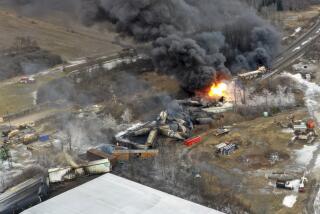‘A Defense of the Commons’ to Meet the New Present Danger : America: With the military threat easing, our R&D; efforts could be directed toward the environmental challenge.
- Share via
America’s national security is in transition. At a time when direct military threats seem to be easing, we are faced with the “present dangers” of a decaying environment, deteriorating infrastructure, declining industry and the need for new energy sources and systems. Each of these problems, if uncorrected, could lead the country into irreversible decline.
The technical and industrial nature of our economy has created serious and long-range environmental threats. Inventing cost-effective ways to dispose of gaseous, liquid and solid wastes, and achieving affordable, non-polluting portable and fixed energy sources constitute complex socioeconomic problems. Their solutions will require new technical systems, processes and devices.
Many of these problems are too complex, pervasive and long term to be solved by legislative fiat (even if the political will existed). Private industry alone certainly cannot be expected to improve its technological competitiveness and pay for cleaning up the environment. There is thus a need to establish a publicly funded environmental-technology base to support the development of the necessary systems and processes.
Under the Constitution, the federal government is charged with the task of providing for the common defense. In the past, this was interpreted in strictly military terms.
With military threats against the United States declining, the government must now provide for a different kind of common defense: protection of the environment and improvement of industrial competitiveness. Accordingly, it must contribute more to finding solutions to the scientific and technical problems associated with the environment and industry. New funding mechanisms, institutions and procedures in support of long-term environmental research and development must be invented to protect the citizenry and assist industry.
Establishing and maintaining such an expanded government commitment to civilian R&D; is not unprecedented in our history. The agricultural experiment stations, the National Institutes of Health and the National Aeronautical and Space Administration are outstanding examples of such a commitment.
Whether civilian R&D; will require the creation of a new government agency or department or simply be an added responsibility of existing federal units, both funding and manpower will be needed. With the federal deficit mounting and with scientists and engineers nearly fully employed, such resources may appear scarce. But as international tensions lessen and the Soviet military threat abates, the need for developing new weapons will ease, thereby freeing up some of the engineers and scientists who have spent up to 50 years working on Pentagon projects.
World events of past months have changed the political maps of the world and promise to change the military maps as well. If the Cold War isn’t “over,” it at least shows signs of waning. Thus, we have an opportunity to shift gears and apply some of our vast R&D; resources now devoted to the military “common defense” to the civilian “defense of the commons.”
More to Read
Sign up for Essential California
The most important California stories and recommendations in your inbox every morning.
You may occasionally receive promotional content from the Los Angeles Times.










